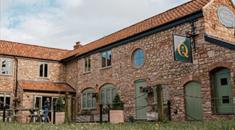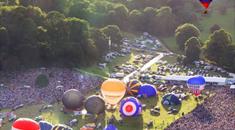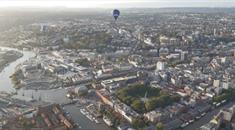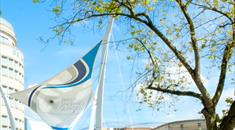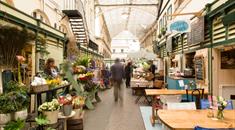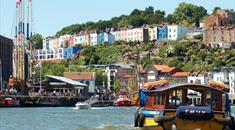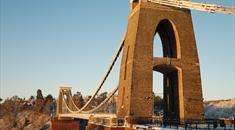Based on the Harbourside, M Shed is Bristol’s social history museum. It explores what makes Bristol the city that it is today and sparks conversations about its past, present and future.
M Shed is also a piece of Bristol history itself, an example of the Harbourside’s journey from busy working docks to buzzy cultural destination.
Keep reading to find out how M Shed came to be and what you can see at the museum today, in its 10th anniversary year.
 Quintin Lake Photography (1).jpg)
Image - M Shed today, credit Quintin Lake Photography
The origins of M Shed
Bristol’s port was the beating heart of the city for hundreds of years. Working docks surrounded the harbour from the 13th century until the mid-1970s.
M Shed stands on Princes Wharf, an area where shipbuilding was taking place from the early 18th century onwards. A store for the Bristol Corporation Granary was built here in 1888, dominating the area for nearly 50 years until it was destroyed by a bombing raid in 1941.
After World War II, two state-of-the-art general cargo sheds – ‘L’ and ‘M’, hence the museum's name – were built here to cope with post-war trade. M Shed was primarily used by the Bristol Steam Navigation Company for its twice-weekly service to Dublin, with bacon, potatoes, beef, butter and Guinness stored there.
Image - m/v “Pluto” loading at new BSNCo berth at Princes Wharf. ‘SS Autumn 1957’ Barrels on quayside. L Shed. Cranes unfinished at M Shed. © Bristol Culture.
After a period of gradual decline, the docks closed to commercial shipping in 1975. But just a few years later, the L and M transit sheds were given a new lease of life as the base for Bristol Industrial Museum and a general museum collections store. Between 1979 and 1988, L Shed was also home to the National Lifeboat Museum.
Cranes, boats and trains: From working dockside to working exhibits
As well as the building itself, another original piece of the working docks that remain at M Shed today are the huge cranes just outside on the quayside. Cranes have been a feature of Bristol’s dockside ever since Alice Chestre, the widow of a Bristol draper and a successful businesswoman, donated £41 to pay for the first one all the way back in 1472.
Over time they became a key feature around the harbour and one of them has even been designated a Scheduled Ancient Monument. The Fairbairn Steam Crane – the only one of its kind that still exists today – was built in the 1870s to lift heavy loads (up to 35.56 tonnes) from the deep hold of ships. It was only used occasionally throughout its working life, except during World War II when it was kept busy handling assault landing craft.
The four cargo cranes that sit beside M Shed are the last of over 40 of this type that lined the city docks in the 1950s. Thanks to a pressure group called City Docks Ventures, these four were saved from being sold for scrap and are now owned by Bristol City Council.

Image - New transit sheds and cranes at Princes Wharf, City Docks ‘Handbook 1953’. © Bristol Culture.
Out on the water, you can see more working exhibits in the form of boats. The Mayflower is the oldest Bristol-built ship still afloat as well as the world’s oldest surviving steam tug, dating back to 1861. There’s also a former firefighting boat, Pyronaut, which was in action every time Bristol was bombed during World War II and remained in service until 1973, and a diesel tug named the John King.
A railway line to transport goods around the harbour was created in 1872 – The Bristol Harbour Railway. After a century as a goods railway, it was handed over to the museum and has run as a heritage railway ever since. Two Bristol-built steam locomotives, Henbury and Portbury, usually pull visitors on trips around the harbour on certain dates, although these are currently on hold due to Covid-19.
What else can you see at M Shed today?
Today, M Shed is home to iconic objects and works of art, documents, photographs, films and personal testimonies that tell Bristol’s story, from its prehistoric beginnings to the present day. Thought-provoking exhibitions reveal stories of industry and invention, of family and factories, of immigration and slavery, and of celebration and hardship.
 Quintin Lake Photography.jpg)
Image - Lodekka bus exhibit, credit Quintin Lake Photography
There are three permanent galleries. Bristol Places looks at the ways that people shape and experience the physical city; how and why its buildings, transport systems and other networks have changed over time.
Bristol People explores the ways in which people have shaped, and continue to shape, the fortunes of the city and how their activities, from music and art to industry, technology and philanthropy, define its character.
And finally, Bristol Life explores the many ways in which people connect socially with each other in Bristol, whether with family and neighbours, at work, in school or out on the town in one of its venues.
Buy the M Shed Souvenir Guide for a deeper dive into the museum’s past and its exhibits.
Next, discover the story of...




 to add an item to your Itinerary basket.
to add an item to your Itinerary basket.











